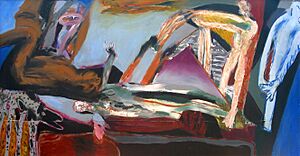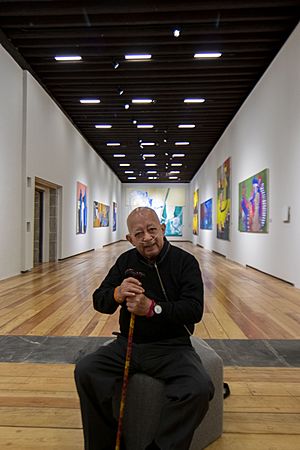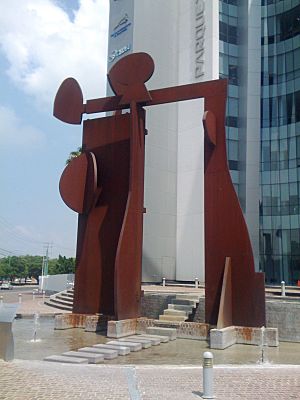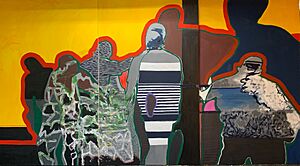Gilberto Aceves Navarro facts for kids
Quick facts for kids
Gilberto Aceves Navarro
|
|
|---|---|
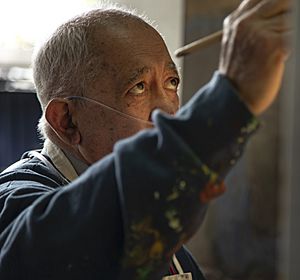 |
|
| Born | September 24, 1931 |
| Died | October 20, 2019 (aged 88) |
| Nationality | Mexican |
| Education | ENPEG "La Esmeralda" |
| Awards | National Prize for Arts and Sciences "fine arts", 2003 |
Gilberto Aceves Navarro (born September 24, 1931 – died October 21, 2019) was a famous Mexican painter and sculptor. He also taught art at important schools like the Escuela Nacional de Artes Plásticas and Academy of San Carlos.
Gilberto Aceves Navarro held over 200 art shows of his own work. His large paintings, called murals, can be found in Mexico, Japan, and the United States. He won many awards for his art, including the Premio Nacional de Ciencias y Artes (National Prize for Arts and Sciences). He also received the Bellas Artes Medal from the Instituto Nacional de Bellas Artes.
Contents
Gilberto Aceves Navarro was born in Mexico City on September 24, 1931. He was the youngest of three children. His mother was an opera singer.
Gilberto started drawing when he was only four years old. He said drawing always felt easy and necessary for him. From a young age, he preferred to be by himself. Being an artist allowed him to enjoy this quiet time. He began school at age seven and learned to read on his own. During his school years, he met famous writers like Carlos Pellicer and Julio Torri.
His family wanted him to study medicine. However, his middle school teacher helped him apply to art school instead. In 1950, he joined the Escuela Nacional de Pintura, Escultura y Grabado "La Esmeralda". There, he took classes with well-known artists. In 1951, he even helped the famous muralist David Alfaro Siqueiros with a project.
Gilberto was not always happy at La Esmeralda art school. He disagreed with some teachers and felt the school focused too much on old art. He believed students should paint from real life. He also felt the school did not give new artists enough chances to show their work. Because of this, he and his friends held their own art shows. They displayed their art in public places like the Alameda Central park. This led the school to open a new gallery for young artists. Gilberto showed his work there twice. He also gained a reputation as a rebel.
In 1952, Gilberto helped paint a government building in Guerrero. When he returned to school, he was not allowed to register. But he secretly continued to study engraving.
Gilberto Aceves Navarro met his wife, Raquel Rodríguez Brayda Longoria, in 1957. They married in 1962. They had one son named Juan Aceves.
After working with Siqueiros, Gilberto started drawing on the streets. He would go out every morning with paper and pencils. He often drew in Parque México. He earned money by selling these drawings. He also painted calendars for a company.
His first art show was called "Energía" at La Esmeralda's gallery. It was very popular. Since his first show in 1954, he has had over 200 individual exhibitions. He has also participated in more than 300 group shows. Since 1970, he has had many exhibitions every year. Most of these were in Mexico, but some were in other countries.
His art has been shown in many places in Mexico City. These include the Salón de la Plástica Mexicana and the Palacio de Bellas Artes. His work has also traveled to other Mexican cities. Outside of Mexico, his art has been shown in the United States, Brazil, Cuba, Chile, Colombia, Uruguay, Japan, and Germany. In 2008, a special show at the Palacio de Bellas Artes featured over 400 of his artworks.
Monumental Artworks
Aceves Navarro created many large artworks, including murals and sculptures. He painted twelve murals in different cities. These cities include Mexico City, Querétaro, Guadalajara, and Veracruz in Mexico. He also created murals in Montreal, Atlanta, and Recife.
In 1970, he painted a mural called Yo canto a Vietnam (I Sing to Vietnam). This was for the Mexico Pavilion at the World's Fair in Osaka, Japan. In 1993, he created Una canción para Atlanta (A Song for Atlanta). This mural was for the 1996 Summer Olympics in Atlanta. In 2006, he made a sculpture called La fuente de la vida (The Fountain of Life). It was placed on Paseo de la Reforma, a famous avenue in Mexico City. In 2010, a new steel sculpture by him was revealed in Querétaro.
Teaching Career
Gilberto Aceves Navarro taught art from the 1950s until his later years. From 1955 to 1957, he taught in Acapulco. He also gave classes in Los Angeles and Mexico City. From 1971 onwards, he taught at the Escuela Nacional de Artes Pláticas and the Academy of San Carlos. At the Academy, he worked to help students create their own art. He wanted them to avoid just copying old works.
Besides teaching at schools, he also taught in his own studio. He started teaching selected students there in 1976. Many of his former students became successful artists. He also gave art workshops in various cities across Mexico.
In 1993, he designed the scenery for two plays.
Awards and Recognition
Gilberto Aceves Navarro received awards from the Salon de la Plástica Mexicana three times. He won the Premio al Mérito Universitario from UNAM in 1989 for his teaching. In 2001, he joined the Academia de Artes. In 2003, he received the Premio Nacional de Ciencias y Artes, one of Mexico's highest honors. In 2011, he was given the Bellas Artes Medal.
Aceves Navarro loved to paint and never stopped, even when he was in his eighties. He enjoyed watching how colors and shapes came together in his art. He believed art was not just a hobby but a necessary part of life. He created murals, oil paintings, drawings, large sculptures, and even wrote poetry.
He felt that drawing was very important to his life. He preferred to work alone in his studio.
His art was influenced by other Mexican artists like David Alfaro Siqueiros. His work is seen as a bridge between the Muralist artists and the Generación de la Ruptura (Breakaway Generation). The Muralists created large public artworks, while the Ruptura artists explored new styles. Aceves Navarro's art is also considered an early example of figurative expressionism. This style uses figures and shapes to express strong emotions.
See also
 In Spanish: Gilberto Aceves Navarro para niños
In Spanish: Gilberto Aceves Navarro para niños


